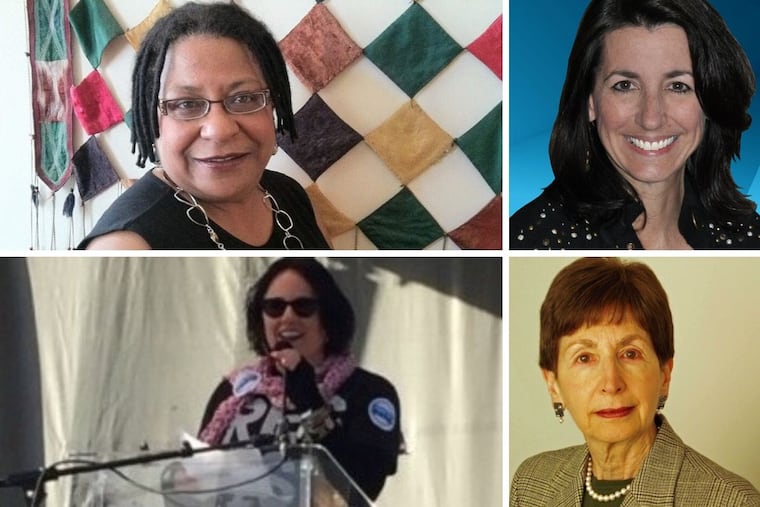Philadelphia has ‘missing men,’ but we’re missing women too — in the halls of power | Opinion
Women outnumber men in Philadelphia by 90,000, yet still lag in leadership positions.

Women outnumber men in Philadelphia by 90,000. According to an Inquirer analysis of census data, that’s the greatest gender imbalance among the nation’s 10 largest cities.
Researchers and observers have looked at this gender gap and wondered where the missing men are. But despite this apparent deficit, which begins at age 25 and increases with age, men aren’t the gender missing in leadership. Women are.
A 2017 report from the Philadelphia Commission for Women found that women owned fewer than 40% of businesses in the city. City Council will seat one more woman in January than it has now but will still be 59 percent male. And Philadelphia has never had a woman mayor.
Even as women dominate the city population, they remain unrepresented in our most powerful positions. Some local visionaries perceive the 90,000 “extra” women as an opportunity for change.
“Looking ahead to November 2020, we are 90,000 strong to elect more women and women of color to office," says Jovida Hill, who heads the Commission for Women. “We’ll be commemorating the 100th anniversary of the 19th Amendment, which granted women the right to vote.”
The numbers in the gender gap show particular disparity by race: Black women outlive black men in Philadelphia by 10 years. While women have better immune systems and tend to survive longer in every society, other likely causes of this difference include the city’s high rate of mass incarceration, violence, insufficient health care, and dangerous jobs, problems that disproportionately affect black Philadelphians.
Hill hopes to encourage the female surplus to vote. “We’ll focus on black women in leadership and on the black women who led the suffrage movement who were intentionally erased from that history,” says Hill.
Philly’s last election showed that fresh female candidates can win: Kendra Brooks, a single mom, community organizer, and political independent, made history and headlines by winning a seat on City Council. And the city Republican leaders chose State Rep. Martina White to become their first female boss.
Jamie Perrapato, a lawyer, is executive director of Turn PA Blue, a statewide organization she cofounded in January 2017 to make the Keystone State vote Democratic next Nov. 3. She hopes to persuade scads of the 90,000 women to work in the suburbs to convert Republican voters. “We need to flip the state legislature from Republican to Democratic,” she says.
We should also ponder board rooms, predictable podiums for male dominance — especially in the nonprofit sector, a rich part of Philadelphia’s professional landscape. This year the Women’s Nonprofit Leadership Initiative (WNLI) and La Salle University’s Nonprofit Center published a profound report on gender diversity on the boards of the 50 largest nonprofit medical and educational institutions in Greater Philadelphia. Local consultant and WNLI member Vicki Kramer says the report, “The Gender Gap in Nonprofit Boardrooms,” recommends including at least 30 percent women on nonprofit boards in the immediate future.
“Gender diversity matters because women on boards differ in what they consider before making critical decisions,” Kramer says. “For example, our research shows that they pay more attention than men do to patients’ health and safety and to student life.”
It’s also a question of advocating for those who most need support. “Nearly half of mothers are the primary breadwinners for their families,” says Diane Cornman-Levy, executive director of Women’s Way, a nonprofit agency that fights for gender equality and justice. “When you invest in women, they invest in the education and health of their children and in their communities. The single greatest determinant of the success of a child is the socioeconomic status of the mother.”
» READ MORE: We’re seeing more women in politics. Is it a quick ‘wave’ or a lasting trend? | Opinion
How do we make these groups more effective? First by raising awareness. “Many people don’t even know that diversity is lacking in these large nonprofits,” Kramer says. The second step: remembering that these organizations — like local government — should answer to their constituents, who can mobilize to make a difference. Nonprofits have stakeholders, such as consumers (students and patients), alumni, employees, and donors. WNLI’s report urges these folks to organize and press their alma mater or medical center to diversify their boards.
In demanding greater representation, we can also build stronger coalitions of women across the city. “Consider the variety of races and ethnicities that we see,” says Cornman-Levy. “Let’s talk about becoming true allies. Let’s build bridges across genders, across races, across ages. If women organize, they can make a difference."
It’s time to double-down on harnessing the power of our nearly 100,000 “extra” women and their decades of professional and life experience.
As Cornman-Levy says: Do the math. “If each of these 90,000 women donated 10 hours and $10 a year to support women’s causes, that could amount to nearly a million dollars and more than 900,000 hours," she says. "That’s 10 years of volunteer time. That would be a movement.”
Susie Perloff, a lifelong Philadelphian, writes nonfiction and teaches adults to write nonfiction. https://writerphiladelphia.com